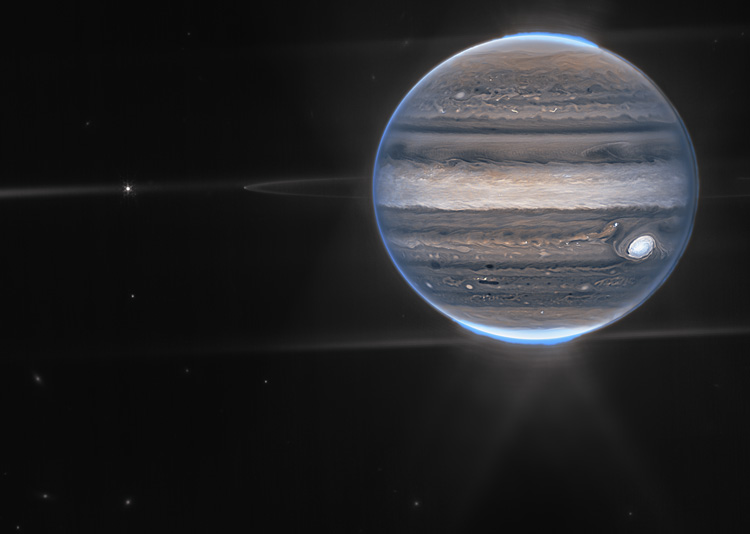JWST infrared image of Jupiter system: with and without text
This false color composite image of Jupiter was obtained with James Webb Space Telescope’s NIRCam instrument on July 27, 2022.
August 22, 2022

[Click image to download high-resolution image] This false color composite image of Jupiter was obtained with the NIRCam instrument on board the James Webb Space Telescope on July 27, 2022. The wide-field color scheme differs from the color composite because this imaging mode used different exposure times and only two filters, mapped in orange and cyan colors. The image shows Jupiter’s rings and some of its small satellites together with background galaxies. Amalthea (~250 x 150 km across) and tiny Adrastea (~20 km across) are visible in this image. The diffraction pattern created by the bright auroras, as well as the moon Io (just off to the left, not visible in the image), form a complex background of scattered light around Jupiter. (Image credit: NASA, European Space Agency, Jupiter Early Release Science team. Image processing: Ricardo Hueso [UPV/EHU] and Judy Schmidt)

[Click image to download high-resolution image] This false-color composite image of Jupiter was obtained July 27 with the NIRCam instrument on board the JWST. Jupiter’s faint rings — a million times dimmer than the planet — and two of its small satellites, Amalthea (left) and Adrastea (dot at edge of ring), are clearly visible against a background of distant galaxies. The diffraction pattern created by the bright auroras and the moon Io (to the left out of the image), form a complex background of scattered light around Jupiter. (Image credit: NASA, European Space Agency, Jupiter Early Release Science team. Image processing: Ricardo Hueso [UPV/EHU] and Judy Schmidt)
FURTHER DETAILS ABOUT THE IMAGES:
Jupiter System: This false color composite image of Jupiter was obtained with James Webb Space Telescope’s NIRCam instrument on July 27, 2022. A combination of short and long exposures in F212N (mapped to an orange color) and F335M (mapped to cyan) show Jupiter’s rings and some of its small satellites together with background galaxies. Amalthea (~250 x 150 km across) and tiny Adrastea (~20 km across) are visible in this image. The diffraction pattern created by the bright auroras, as well as the moon Io (just off to the left, not visible in the image), form a complex background of scattered light around Jupiter.